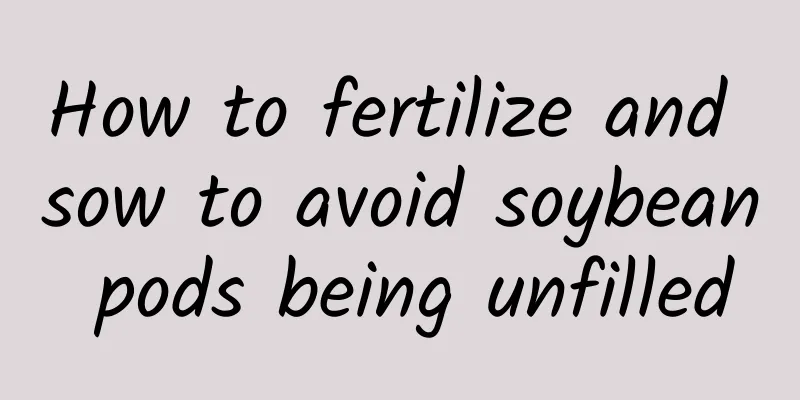How to fertilize and sow to avoid soybean pods being unfilled

|
We are all familiar with soybeans. The soybean oil we often consume is extracted from soybeans. When we grow soybeans, what we are most afraid of is that the soybean pods are not solid, which will seriously affect the yield and quality of soybeans. How can we avoid this situation? Let's read the article to find out! How to fertilize soybean pods when they are not fullWhen planting soybeans, unscientific fertilization and excessive nitrogen fertilizer proportion will cause the stems to grow too high and too vigorously, resulting in large and dense branches and leaves that are green and look good but are not practical, forming empty or half-empty pods, or sparse flower pods and delayed maturity. Apply fertilizers such as phosphorus, potassium, and boron that are helpful for soybean pod formation and reduce the occurrence of barren grains. Soybeans require a lot of nutrients for flowering and pod formation. Applying base fertilizer and seed fertilizer alone often cannot meet the growth needs. Top dressing should be done during the flowering period. How to sow soybeans to avoid unfilled podsArrange the sowing period well to allow soybeans to bloom and avoid the high temperatures during summer. Take advantage of the relatively short days and low temperatures before and after summer to allow soybeans to smoothly enter the grain-filling stage and prevent them from having pods but no grains. Some late-maturing soybean varieties bloom and set pods very late. When these late-maturing varieties bloom and set pods, they encounter cold and rainy weather, which weakens the photosynthesis of soybean leaves, and the development of young pods slows down or even stops, resulting in hollow pods. How to spray soybean foliar fertilizerBoron deficiency in the soil can easily cause soybean pods to be unfilled. When planting soybeans, spray 0.1% borax every 7 to 10 days during the initial flowering period of soybeans. It is best to spray 0.5% urea and 0.2% potassium dihydrogen phosphate for 3 consecutive times. This can effectively prevent soybean pods from being unfilled. When spraying foliar fertilizer, be sure to control the concentration. It is best to spray on cloudy days or on sunny days after the sun sets. This can prevent the foliar fertilizer from drying up quickly and is conducive to the plant's absorption of the foliar fertilizer. Related NewsSoybean is an annual herb and the most important legume in the world. Soybean originated in China. Most Chinese scholars believe that the origin is the Yunnan-Guizhou Plateau. Many botanists also believe that it is derived from the Ussuri soybean, which is native to China. The cultivated soybean currently grown is derived from wild soybean through long-term directional selection, improvement and domestication. |
>>: Is it easy to raise seven-leaf lotus? How can seven-leaf lotus grow vigorously?
Recommend
When will masks be available in normal supply? When will masks be out of stock?
We all know that masks are a common type of prote...
What are the differences between bb cream and cc cream? You will understand everything after reading it!
Most women are very familiar with BB cream and CC...
Is a breast nodule a lump? What is the difference?
We all need to have a correct understanding of th...
Left lower abdominal pain after abortion
Abortion is a common way in clinical medicine to ...
Can pregnant women eat beef jerky in the early stages?
Whether they are already pregnant or preparing fo...
Sprout Social: 2019 Social Media Index Report
Sprout Social has released a new report, the 2019...
What causes endometritis?
The uterus is a very important organ in the femal...
What is the cause of a small amount of tricuspid regurgitation in the fetus?
Nowadays, many pregnant mothers will encounter so...
7 ways to prevent breast sagging
Breast sagging can make a woman's figure a li...
What tests are done for gynecological diseases?
Recently, gynecological diseases have caused grea...
Can eating crabs reduce milk production?
Many breastfeeding women may choose to stop breas...
Eight little secrets of the female vagina
It's well known that the penis becomes erect ...
Symptoms of intrauterine polyps, what are intrauterine polyps
Intrauterine polyps are a disease that female fri...
What are the symptoms of a girl's pregnancy?
Pregnancy is the most important stage for every g...









